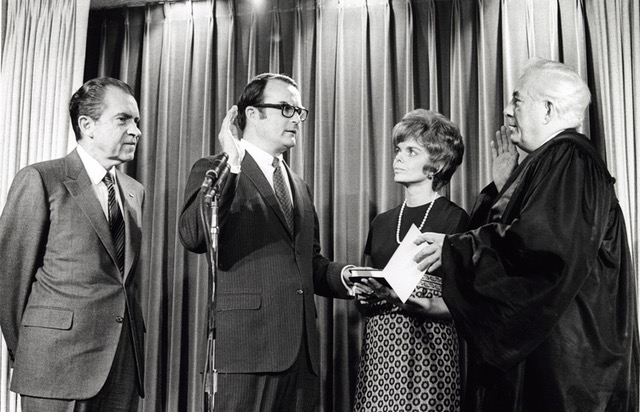It was a turning point in the history of environmental policy. In 1972, the first head of the EPA, William Ruckelshaus, faced “a preponderance of the evidence” showing the effects of the pesticide DDT on birds and other wildlife.
By then, Rachel Carson’s book Silent Spring had become a classic, clearly laying out the adverse effects of the pesticide. DDT sprayed on crops was poisoning the ecosystem, causing the thinning of eggshells for birds like the bald eagle, accumulating in the fatty tissues of animals and wiping out many more creatures than the crop-eating insects it was targeting.
The case against DDT was seen by many as overwhelming, but the decision to ban the pesticide was by no means preordained. The EPA faced major legal challenges and Ruckelshaus proceeded surely and meticulously, weighing the scientific evidence with a lawyer’s eye. His carefully laid out opinion became a case study on the role of science in policy.
“I am convinced by a preponderance of the evidence that, once used DDT is an uncontrollable, durable chemical that persists in the aquatic and terrestrial environments,” he wrote, giving the scientific findings a legal framework (“a preponderance of the evidence” was a lawyerly phrase Ruckelshaus would use more than once) that would jumpstart the newly formed EPA.
It was really just the beginning. Over the years, Ruckelshaus’s evidence-based approach would become familiar as he faced other major decisions at the EPA, and eventually later as a champion and organizer of Puget Sound recovery efforts.
When William Ruckelshaus (known to many informally as “Bill”) died on November 27th, he left such a broad legacy of accomplishments that his work as the country’s first EPA administrator sometimes did not even make the lead in his obituary. He is often first remembered as a key player in the so-called “Saturday Night Massacre” when he resigned rather than comply with President Richard Nixon’s order to fire special prosecutor Archibald Cox. Cox had been assigned to investigate the Watergate break-in that eventually led to impeachment proceedings against Nixon.
“I thought what the president was doing was fundamentally wrong,” he later told The New York Times. “I was convinced that Cox had only been doing what he had the authority to do…He hadn’t engaged in any extraordinary improprieties, quite the contrary.”
After resigning his post and eventually leaving Washington, D.C. in 1975, Ruckelshaus moved to the other Washington, where his environmental and policy legacy would continue — along with a sidetrack to head the EPA a second time in the 1980s. When the Washington State Legislature formed the Puget Sound Partnership in 2007, Ruckelshaus was a natural choice as co-leader. He had already been a chief organizer, along with Billy Frank, of the state’s Shared Strategy to recover Chinook salmon. The success of that venture from 1999 to 2001 had shown policymakers the value of coordinated state, tribal and federal environmental efforts. If such a thing could be done for salmon, why not the entire Puget Sound?
“Bill’s legacy echoes in almost everything we do,” recalls Ken Currens, who worked with Ruckelshaus on Chinook recovery and later served as the first science director of the Puget Sound Partnership. Currens, now manager of the Conservation Program at the Northwest Indian Fisheries Commission, says Ruckelshaus was a master at connecting science with policy. “I think he understood the huge value of science in terms of providing clarity and clearing up uncertainty. And it was something that people could agree on. It was fact based.”
During his tenure, Ruckelshaus regularly attended the Puget Sound Partnership’s Science Panel meetings, and “he was not afraid to ask scientists hard questions,” Currens remembers. “He knew they were hard questions, but when you looked at him you could also see that he had a twinkle in his eye. He knew he was putting you on the spot, so there was kind of this sense of humor that went along with it that made it OK.”
He also knew that science offered few quick fixes. He expected that cleaning up Puget Sound would take some time. Back in 2005, before the creation of the Puget Sound Partnership, his views were prescient. “It’s relatively easy to generate a lot of enthusiasm for Puget Sound in the short term,” he said. “Sustaining the effort to clean it up is somewhat tougher.”
Now, as the effort to clean up Puget Sound moves into 2020 and beyond, it will have to continue without Ruckelshaus. “He carried the ball for a long time,” says Currens. Judging by a preponderance of the evidence, he will be missed.
–Jeff Rice, Puget Sound Institute
